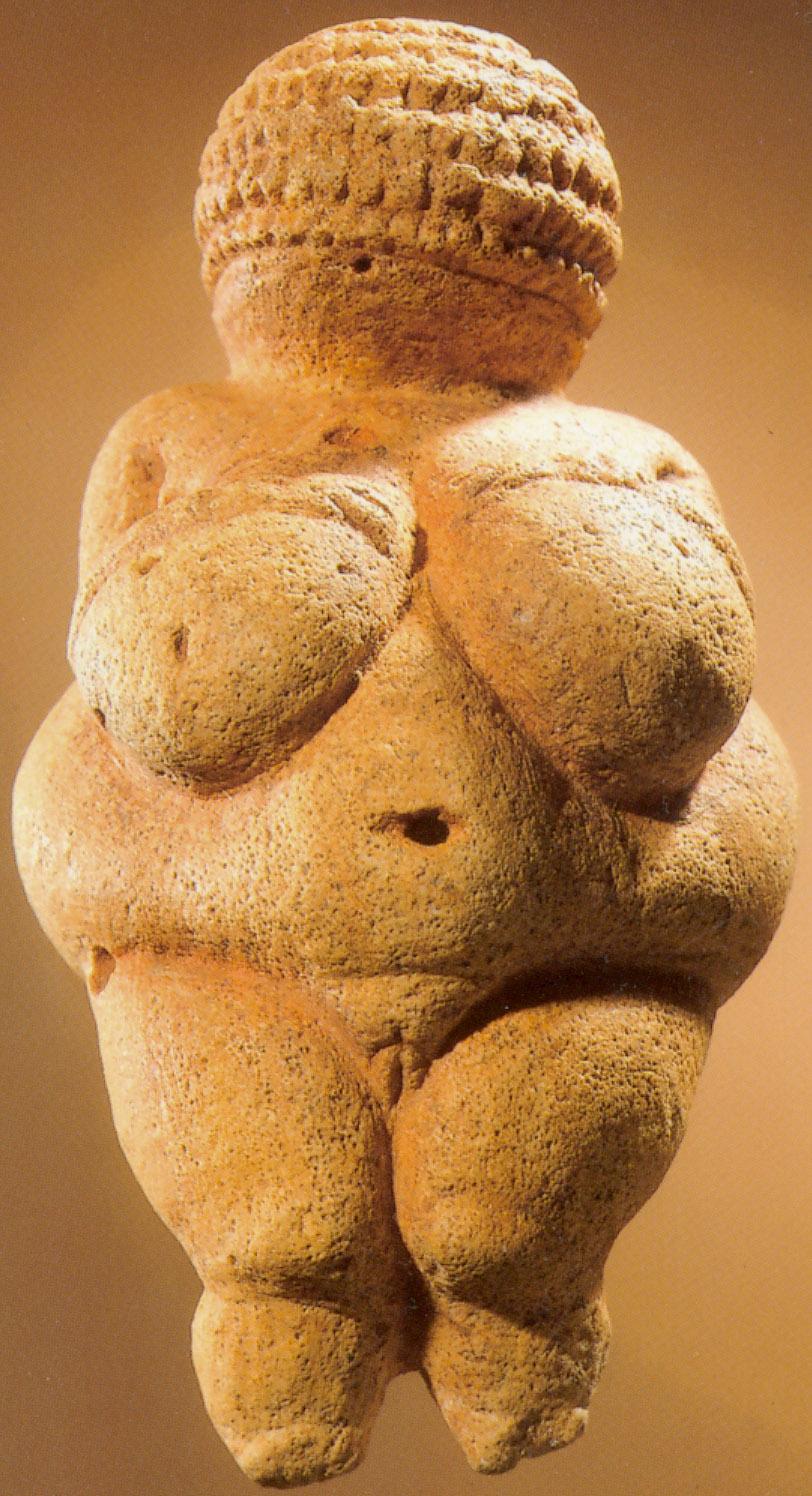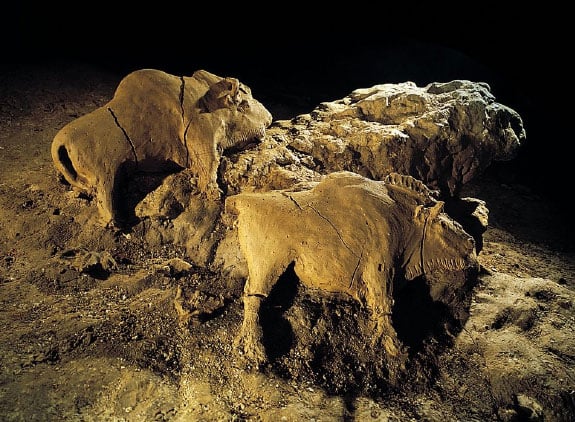Cards In This Set
| Front | Back |
 *Title? *Location? *Time? *Material(s)? *Significance of location? Assumptions? *When did humans intentionally manufacture sculptures and paintings? *Name another artist with a piece who did not craft his/her art, but called a random object art? |
*"Waterworn pebble resembling a human face"
*Makapansgat, South Africa *Ca. 3,000,000 BCE *Reddish-brown jasperite *The nearest known source of this variety of this ironstone was 20 miles away from the cave. This may mean that one of the early humans who took shelter in the cave found the rock and brought it back to the cave for "safekeeping". *30,000 BCE *Duchamp (1917), "Fountain" (The urinal, set on it's side) |
 *Title? *Location? *Time? *Material(s)? *Describe the species and the form of the animals in relation to one another. *In Paleolithic times, what were the most common subjects? *The most common presentation style? Why? *What was the aim of the earliest painters? |
*"Animal Facing Left"
*The Apollo 11 Cave, Namibia *Ca. 23,000 BCE *Charcoal on Stone *The species is uncertain, but the forms are always carefully rendered. *Animals *Strict profile is completely informative about the shape of the animal. *To create a convincing image of the subject, like a visual definition. |
 *Title? *Location? *Time? *Material(s)? *What was the most sginificant aspect of this statuette for the era in which it was created? *What does this statuette represent? *What were these figures often called? |
*"Human with Feline Head"
*Cave in Hohlenstein-Stadel, Germany *Ca. 30,000-28,000 BCE *Mammoth Ivory *It's scale! A foot was very large for this time period. *Something that existed only in the imagination of the creator. *"Sorcerers" (Magicians wearing masks or humans wearing masks) |
|
Name a pointed engraving tool that was used during this time?
|
A "burin".
|
|
What does it mean to "incise"?
|
To scratch/carve.
|
 *Title? *Location? *Time? *Material(s)? *Describe the form (3). *What does the exaggerated proportions say about the use of this piece? *What does the preponderance of female over male figures in the Old Stone Age seem to indicate? *What did this piece NOT aim for? *With with technique was this piece created? |
*Nude woman ("Venus of Willendorf")
*Ca. 28,000-25,000 BCE *Limestone *Exaggerated anatomy, Ball-like clusters, Fertile image. *Could have been used as a fertility image. *A preoccupation with women, whose childbearing capabilities ensured the survival of the species. *Naturalism in shape and proportion. *It was carved "in the round". |
 *Title? *Location? *Time? *Material(s)? *This piece is one of the earliest examples of what? *Describe this piece before it was put into a museum? *What was applied to this figure after it was carved? *This piece exaggerates what features (3)? |
*"Woman Holding a Bison Horn" (Commonly known as "Laussel Woman")
*Laussel, Dordorgne, France *Ca. 25,000-20,000 BCE *Painted limestone *Relief sculpture *This piece was part of a great stone block standing in open air in front of a rock shelter. *Red ochre, also found on the Venus of Willendorf *Breasts, abdomen, and hips. |
 *Title? *Location? *Time? *What type of piece is this? *What did the artist use as the basis for his/her representation? *After selecting a canvas wall, what were the next steps of the Old Stone Age painter's process? *What two aspects of this piece are very similar to both the Venus of Willendorf and the Laussel Woman? |
*"Reclining Woman"
*La Magdelaine Cave, Tarn, France *Ca. 12,000 BCE *A rock-cut relief *The natural contours of the stone wall *He/she accentuated the outlines and added internal details to the figure with a stone chisel *Breasts and pubic triangle are very exaggerated and there is a lack of facial features |
 *Title? *Location? *Time? *Material(s)? *What were these reliefs modeled against? *What presentation are the bison in? *Describe the process of aming this piece *Why are there cracks in the animals? |
*"Two Bison"
*Cave at Le Tuc d'Audoubert, Ariege, France *Ca. 15,000-10,000 BCE *Clay *A large, irregular freestanding rock in a cave *Strict profile *The sculptor brought the clay from another chamber in the cave complex and modeled it by hand into the overall shape of the animals. Then he smoothed the surfaces with a spatula-like tool abd finally used fingers to shape the eyes, nostrils, mouth, ad manes. *They are results from the drying process and probably appeared within days of the sculptures' completion |
|
Which of these images is among the largest Paleolithic sculptures known?
|
"Two Bison"
|
 *Title? *Location? *Time? *Material(s)? *Describe this piece in comparison to the bison in the cave at Le Tuc d'Audoubert. *What is especially significant about this piece? What could have contributed to this? |
*"Bison with Turned Head"
*La Madeleine, Dordogne, France *Ca. 12,000 BCE *Reindeer horn *This engraving is much more detailed and extends to the horns, eye, ear, nostrils, mouth, and the hair on the face. *The choice of the artists to represent the bison with his head turned. This could have been influeced by the small size of the reindeer horn. |
 *Title? *Location? *Time? *Age? *What name is associated with this piece? *Why do Prehistorians ragard cave paintings as rare occruences? *Why are these bison often called "floating"? |
*"Bison"
*Detail of a painting in the Altamira cave, Santander, Spain *Ca. 12,000-11,000 BCE *13,000-14,000 years *Sanz de Sautuola *Because there were created over a period of some 10,000-20,000 years. *They do not stand on a common ground line, nor do they have the same orientation. |
 *Title? *Location? *Time? *What would be the process of creating a "positive" hand imprint? *What would be the process of creating a "negative" hand imprint? *What does this print function as? |
*"Spotted Horses and Negative Hand Imprints"
*Wall painting in the cave at Pech-Merle, Lot, France *Ca. 22,000 BCE *Dipping your hand into paint and placing it on the wall. *Placing your unpainted hand against the wall and brushing paint around it. *A signature. |
 *Title? *Location? *Time? *How are the animals in this piece represented? *Two basic approaches of representing these animals were used. What does this suggest? *Which convention of representing horns is seen in this piece? Why? *The painter's approach is not .... *The approach is ___________ of the fact that cattle have two horns. |
*"Hall of the Bulls (left wall"
*Lascaux, Dordogne, France *Ca. 15,000-13,000 BCE *Colored silhouettes, some were created by outline alone *That the animals were painted at different times *A twisted perspective, because viewers see the heads in profile, but the horns from the front. *Seen from a fixed viewpoint. *Descriptive |
 *Title? *Location? *Time? *This one of the earliest appearances of what in Paleolithic cave paintings? *How is the bison painted in this piece? *Are these images related at all? |
*"Rhinocerous, Wounded Man, and Disemboweled Bison"
*Painting in the well of Lascaux, Dordogne, France *Ca. 15,000-13,000 BCE *Man, as opposed to woman *Schematically *It is unknown, this is one of the greatest mysteries about this piece |



